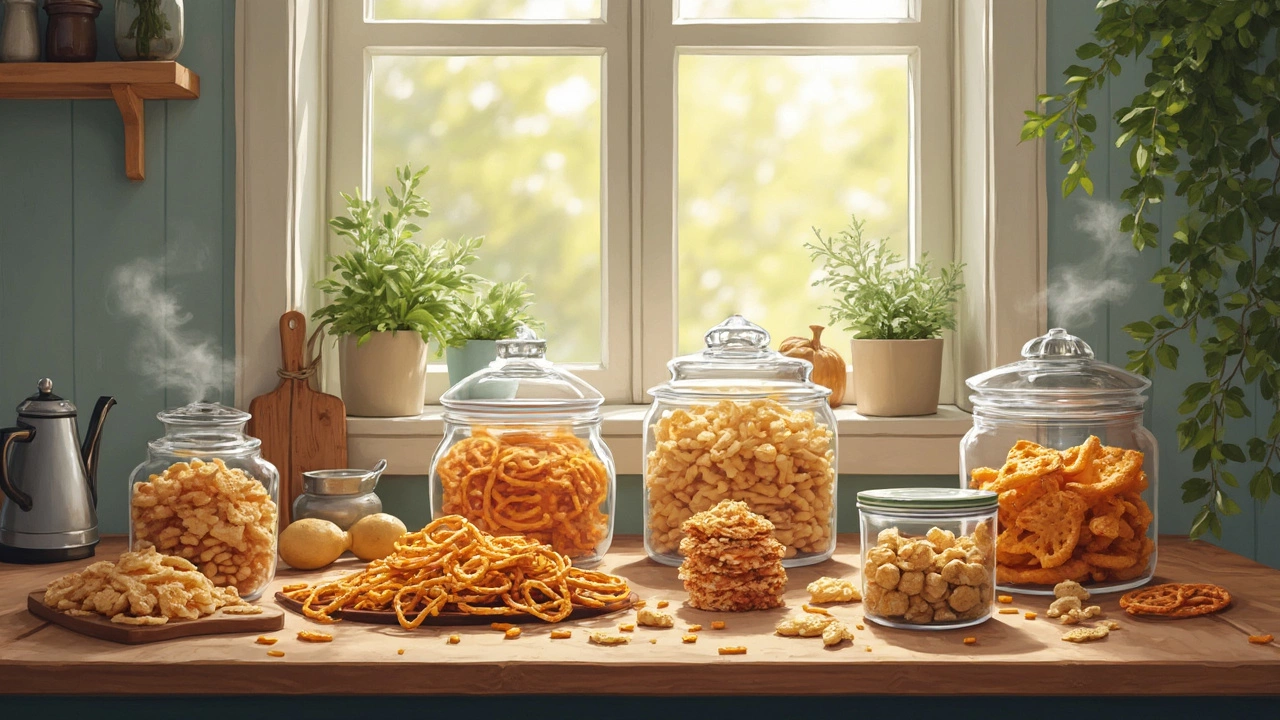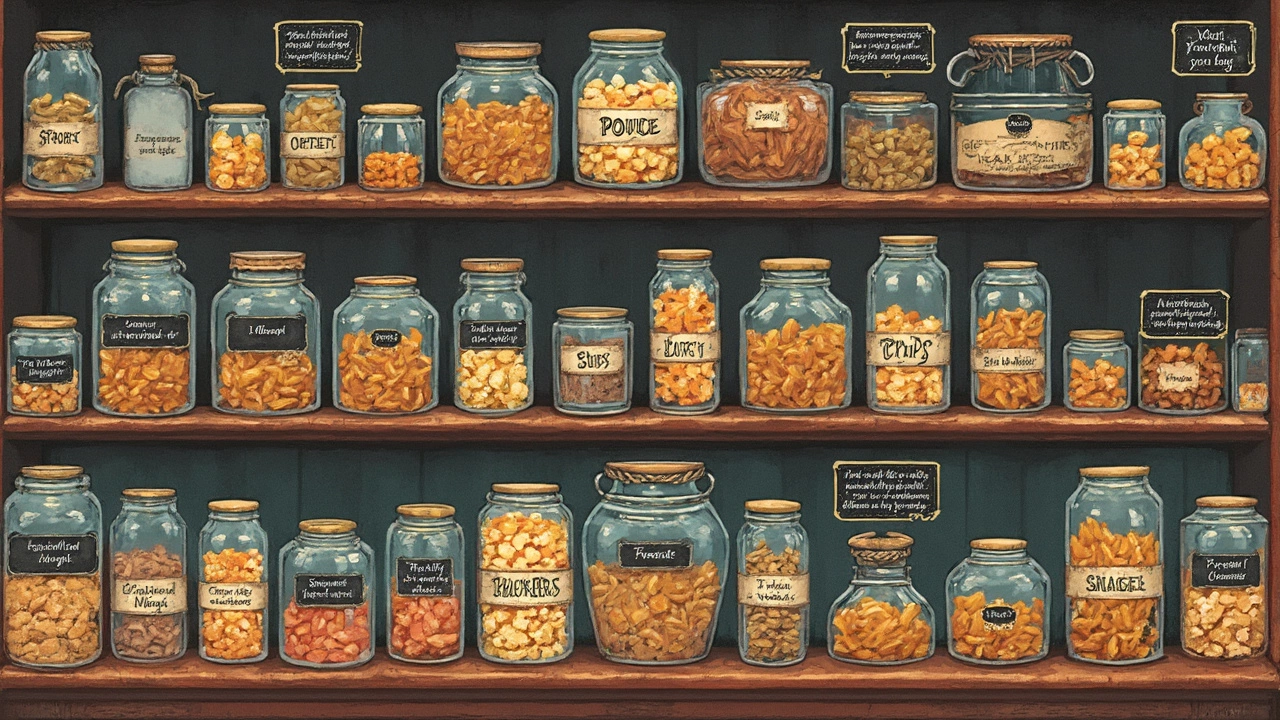
Ever found yourself frustrated with soggy snacks? Well, you're not alone! Keeping those delicious nibbles crisp is a common culinary puzzle. Moisture is usually the sneaky culprit, creeping in and transforming your crunchy bites into limp disappointments.
The good news? There are plenty of tricks to outsmart the sogginess monster, starting right from the preparation stage. For instance, did you know that simply letting your fried snacks cool completely before storing them can make all the difference? It helps reduce steam, which is a major moisture maker.
- Understanding Sogginess
- Preparation Techniques
- Proper Storage
- Serving Suggestions
- Common Mistakes to Avoid
Understanding Sogginess
Before we battle with sogginess, let's get to know our opponent. At its core, sogginess happens when food absorbs more water than intended. Often, this comes from the environment, like humidity in the air or steam from freshly cooked food.
Savory snacks like fried chips or crackers have crunch from their low moisture content. Think of them like sponges, waiting to soak up moisture, which is why they sometimes lose their crisp. Learning what causes this helps us keep that alluring crunch for longer.
The Science Behind Sogginess
Each snack has what scientists call a 'critical moisture level.' Going above this level turns crunchy into soft. This happens faster in humid environments, where the air is heavy with water. You can actually use this knowledge to your advantage by monitoring the moisture content in your kitchen.
Frying and Baking Insights
If you've ever fried food, you know oil can play a part in sogginess. Freshly-fried snacks need time to breathe and let off steam, quite literally! This steam escapes as the snack cools, preventing it from condensing back into water inside your snack. For baked goods, sometimes under-baking leads to more moisture, causing them to go limp faster.
By understanding the battleground of sogginess, you can arm yourself with the right techniques to keep your snacks fresh and crunchy longer.
Preparation Techniques
Before we even think about storage, getting the preparation right is key to ensuring your savory snacks don't end up soggy. It all starts with the ingredients and the cooking method.
Dry Ingredients
First things first, make sure your ingredients are dry. It's super important, especially for fried goodies. Wet ingredients lead to steam, and we all know steam is the enemy of crunch. Pat them dry with a paper towel before you move to the next step.
Temperature Matters
Getting the right temperature is a game-changer. For fried snacks, the oil should be hot enough, ideally between 350°F (175°C) and 375°F (190°C). This creates a crispy outer layer quickly, locking moisture inside where it should be.
Timing is Everything
Don't rush the process. Crowding the pan drops the oil temperature, resulting in soggier snacks. Fry in small batches for the best results.
Cooling Properly
After cooking, cool your snacks on a wire rack. This lets air circulate all around, preventing moisture build-up underneath, which causes sogginess.
- Pat dry ingredients before cooking.
- Keep oil temperature steady.
- Fry in small batches.
- Always cool on a wire rack.
These simple steps ensure you get the best texture and flavor from your snacks. Give it a shot, and enjoy the crunch!

Proper Storage
Storing your savory snacks the right way is crucial if you want to avoid the dreaded sogginess. Let's get into some practical ways you can keep your snacks fresh and crispy.
Cool and Dry Storage
First off, always let your snacks cool completely before packing them away. Steam is like a supervillain in the world of snack storage—it creates condensation, which turns into moisture, the enemy of crispiness. So, be patient and let that heat escape before securing them in any containers.
Airtight Containers are Your Best Friend
Invest in some good quality airtight containers. These seal in the crunch by keeping moisture out. If you don't have one on hand, a resealable plastic bag with the air squeezed out works in a pinch too.
Layer with Paper Towels
For extra protection, layer your snacks with paper towels before sealing them up. Paper towels act as moisture absorbers, ensuring that excess humidity doesn’t ruin your perfectly cooked bites.
Consider the Fridge Wisely
Pop a few snacks in the fridge? Sure, but only for short-term storage; otherwise, they can get moisture damage over time. Sometimes, a quick rest in the fridge helps if you plan to snack on them soon after.
| Storage Method | Average Freshness Duration |
|---|---|
| Airtight Container | 3-5 days |
| Resealable Bag | 1-3 days |
| No Storage | 1 day |
Don't Forget to Reheat!
If you find yourself with snacks that have lost their crunch, give them another quick bake in the oven. A few minutes at around 180°C (350°F) can revive that crispy texture.
By following these kitchen hacks, you can make sure sogginess is a thing of the past. With a bit of care, your snacks can stay as tasty and fresh as the moment you made them!
Serving Suggestions
Making sure your savory snacks stay crisp when served is just as important as preparation. You don't want all your efforts to go to waste as soon as they hit the table. So, how do you do it?
First, consider serving on a tray with some ventilation. A raised rack or a tray lined with paper towels can help keep air circulating around your snacks. This means they won't sit in their own steam, which leads to that dreaded sogginess.
Temperature Matters
Keep hot savory treats warm in the oven on a low heat until you're ready to serve. This holds true especially for things like fried snacks or baked goods. They stay crispy for longer when they're warm rather than hot or cold.
"Moisture is the enemy of crispness," says Jane Parrish, a renowned culinary expert, "and understanding how to manage it can transform your cooking outcomes."
Serving Timing
Timing can also make a big difference. Serve your snacks right after their final preb serving check, ensuring that they're fresh. This works wonders with guests marveling at the crunch!
Climate Considerations
| Serving Environment | Recommendation |
|---|---|
| Humid | Use fans or air conditioning to reduce air moisture. |
| Dry | No extra steps; your snacks are safe from sogginess! |
Be mindful of the environment where you're serving. If it's too humid, your tips might need a little backup, like a dehumidifier.
Remember, practice makes perfect. Try these tips next time, and say goodbye to soggy snacks. Your guests will thank you!

Common Mistakes to Avoid
Avoiding sogginess in your savory snacks might seem tricky, but keeping an eye out for some common pitfalls can make all the difference. These are some traps you definitely don't want to fall into:
1. Storing While Warm
Pop them into a container too soon, and you'll trap that steam inside. Steam equals moisture, and moisture equals sogginess. It's tempting to clean up immediately, but patience here pays off. Let them cool completely before storing.
2. Keeping in Non-Airtight Containers
Leaving snacks in air-exposed containers is a disaster for keeping them crispy. Always go for airtight jars or resealable bags. They lock out the moisture and preserve that delightful crunch we all crave.
3. Ignoring Humidity Levels
Humidity is another big enemy. If you live in a humid area, it's a good idea to add a few silica gel packets around your snack storage. They're dry and safe, and can amazingly absorb excess moisture. This simple addition can be a game-changer.
4. Using Improper Coating
A well-chosen coating can form a protective barrier against moisture. A classic mistake is skimping on the coating mix or cutting corners. Stick with tried-and-true recipes that ensure a satisfying crispness.
5. Serving on Damp Plates
Here's a lesser-known faux pas: serving snacks straight on damp plates. If your plate's picked up even a little moisture, it's enough to ruin the textures. Always make sure they're dry before putting your snacks on.
By sidestepping these missteps, you're well on your way to maintaining snack perfection. Keep these tips in mind, apply them, and enjoy truly crunch-tastic savory snacks every time!